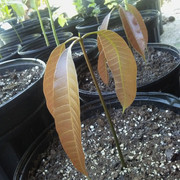I live in Scottsdale, AZ. I have a fair amount of tropicals, such tropicals. But, really trying to get a definitive graspecial on what tropical/subtropical trees/shrubs wI'll grow out here long term.
It is obvious that citrus are no brainers, along with pomegranate.
But, I would really is get all of your expert opinions on what to grow out here.
Of course, it is rarely easy enough for things to be a yes it will, no it won't. So I would like to categorize fruit plants as following.
1. Plant in ground, will grow well.
2. Plant in ground, will need protection from afternoon sun.
3. Plant in ground, but, needs to be planted in a warm microclimate or covered in a frost cloth.
4. Potted plant only, needs to be brought inside for winter.
5. Don't grow. Cannot survive longterm in pot and cannot take 9b winter conditions.
Thoughts on my list? Anything add, subtract, combine?
Really asking anyone on here to contribute. Even breaking down varieties that might do better.
If you read online, very hard to get truth vs sale pitch. Also, fair amount of people out here making claims they cannot support for sales. Would be nice to have a reference for people looking to buy and grow out here, and have the confidence they are not waiting their money.
Hi,
I am in the same are as you. I have only been into the more tropical plants since about two years ago, but i'll share what I have gathered so far.
Guavas for me are almost bullet-proof. All mine are in full sun and grow like crazy as long as they have well draining soil and water. I have 4 different varieties and all are loaded with fruit. The only bummer is they defoliate under frosty conditions, but they bounce-back around may-jun.
Passiflora edulis is in the same boat as guavas, they love sun, heat, water, and something to climb on. They seem slightly more frost tolerant than guava.
I have been having trouble with mangos here, I believe it is due to a combo of pests and some disease issues. All the mangos I plant do well for about 6-8 months then suddenly and quickly desiccate and die. The death starts as a black necrosis that quickly kills the tree. I think whatever this is kills the tree because of our crappy alkaline soil which causes nutrient deficiencies. IDK though, I have some other mangos planted in mounds under shade that seem to be doing well, we will see. Im currently growing some seedlings as well, hoping for especially vigorous trees.
I have two avocados that are doing well, they need lots of shade here (all the time) and humidity. Mine are planted in the canopy of a massive naval orange tree.
Annona reticulata for me is pretty tough, it seems ok to about 110. Then it needs shade/ wind protection.
Annona squammosa is the same, except it seems less heat tolerant.
Green sapote. This one is doing way better than I thought, it is in full shade and survived a 123 degree day with no problem.
Im going to be expanding my garden this fall, I hope to address the soil pH issues with a boat load of sulfur and leonardite.
One more thing. I have a bunch of potted tropicals. I always thought a good moisture retaining soil would be ideal for hot AZ, but boy have I been wrong. Pretty much any store bought potting soil causes root rot in my potted plants. The surface dries up super quickly, but the bottom of the pot stays muggy and damp leading to rot. I recommend making your own potting soil with 50% course sand ( ideally basalt) 25% peat or coir, and 25% of something chunky like bark. Just make sure you feed often because this mix has basically no nutrients. But the massive amount of sand means you can literally water every day without overwatering.
This has been my experience so far, but like I said I have only been doing it for about two years. I think most of the tropical fruit growing is newer to AZ, which is kind of cool.

